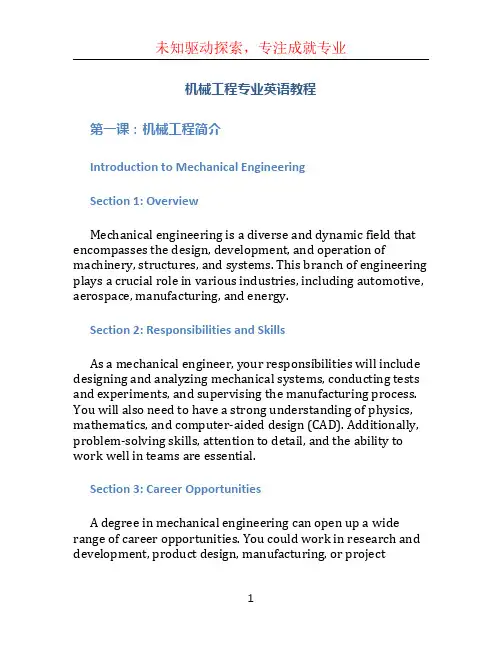机械工程专业英语教程 (34)[16页]
- 格式:ppt
- 大小:4.86 MB
- 文档页数:16
![机械工程专业英语教程 (41)[10页]](https://uimg.taocdn.com/241041555a8102d276a22fd9.webp)

![机械工程专业英语教程 (第5版)课件 (45)[9页]](https://uimg.taocdn.com/06fd4829fe4733687f21aa4c.webp)
![机械工程专业英语教程 (第5版)课件 (55)[9页]](https://uimg.taocdn.com/cd1c3b8f804d2b160a4ec000.webp)
![机械工程专业英语教程 (第5版)课件 (47)[9页]](https://uimg.taocdn.com/55a5870e7e21af45b207a84c.webp)
![机械工程专业英语教程 (第5版)课件 (65)[10页]](https://uimg.taocdn.com/84f186158bd63186bdebbc00.webp)
![机械工程专业英语教程 (第5版)课件 (16)[8页]](https://uimg.taocdn.com/2b1e1e66b52acfc788ebc945.webp)
![机械工程专业英语教程 (第5版)课件 (44)[8页]](https://uimg.taocdn.com/56ad4a2133687e21ae45a94c.webp)
![机械工程专业英语教程 (第5版)课件 (51)[10页]](https://uimg.taocdn.com/96364dc6844769eae109edb5.webp)
![机械工程专业英语教程 (第5版)课件 (28)[11页]](https://uimg.taocdn.com/3b87a364dd3383c4ba4cd2b5.webp)

机械工程专业英语教程第一课:机械工程简介Introduction to Mechanical EngineeringSection 1: OverviewMechanical engineering is a diverse and dynamic field that encompasses the design, development, and operation of machinery, structures, and systems. This branch of engineering plays a crucial role in various industries, including automotive, aerospace, manufacturing, and energy.Section 2: Responsibilities and SkillsAs a mechanical engineer, your responsibilities will include designing and analyzing mechanical systems, conducting tests and experiments, and supervising the manufacturing process. You will also need to have a strong understanding of physics, mathematics, and computer-aided design (CAD). Additionally, problem-solving skills, attention to detail, and the ability to work well in teams are essential.Section 3: Career OpportunitiesA degree in mechanical engineering can open up a wide range of career opportunities. You could work in research and development, product design, manufacturing, or projectmanagement. Mechanical engineers are in demand in almost every industry, ensuring a stable and rewarding career path.Section 4: University CoursesTo become a mechanical engineer, it is essential to pursue a degree in mechanical engineering from a reputable university. The curriculum typically includes courses in engineering principles, materials science, thermodynamics, fluid mechanics, and mechanical design. Additionally, practical training through internships or cooperative education programs is crucial for gaining hands-on experience.Section 5: ConclusionMechanical engineering offers a challenging and rewarding career for those with a passion for solving problems and a desire to create innovative solutions. With the right education and skills, you can embark on a successful journey in the field of mechanical engineering. Remember, the possibilities are endless in this ever-evolving discipline.第二课:机械设计基础Fundamentals of Mechanical DesignSection 1: IntroductionIn this lesson, we will explore the fundamentals of mechanical design. Mechanical design involves the creation and development of physical systems and components that meet specific requirements and specifications. This processrequires a deep understanding of materials, mechanics, and engineering principles.Section 2: Design ProcessThe design process typically follows a systematic approach that includes several stages. These stages include problem identification, conceptual design, detailed design, manufacturing, and testing. Each stage involves various activities such as brainstorming, prototyping, and evaluation.Section 3: Design ConsiderationsDuring the design process, there are several important considerations to keep in mind. These include functionality, efficiency, reliability, safety, and cost-effectiveness. It is also crucial to consider the environmental impact and sustainability of the design.Section 4: Tools and SoftwareTo aid in the design process, engineers use various tools and software. Computer-aided design (CAD) software allows for precise modeling and simulation of mechanical systems. Finite element analysis (FEA) software helps in analyzing the structural integrity and performance of designs.Section 5: Case StudyTo further understand the application of mechanical design principles, we will examine a case study. This real-world example will demonstrate how the design process isimplemented to solve a specific problem and achieve desired outcomes.Section 6: ConclusionMechanical design is a critical aspect of mechanical engineering. It requires a combination of creativity, technical knowledge, and attention to detail. By mastering the fundamentals of mechanical design, you will be well-equippedto tackle complex challenges and contribute to the development of innovative solutions.以上是《机械工程专业英语教程》的课文翻译。